Click On Image
For Full Size Image |
Size |
Image Description |
Contributed
By |
Namesake
|

| 59k | Littleton Waller Tazewell Waller was born in York County, Va., on 26 September 1856 and was appointed as a second lieutenant of Marines on 24 June 1880 and served initial tours of successive shore duty at the Marine Barracks in Norfolk, Va., and Washington, D.C. Going to sea in Lancaster, the flagship of the European Squadron, in 1881, Waller participated in the landing of a mixed bluejacket and marine landing force at Alexandria, Egypt, during a serious local uprising in the summer of 1882. The timely arrival of the ships of the European Squadron and their landing forces gave protection to the American consulate and to American citizens and interests and also afforded a refuge for the citizens of other nations who had been displaced from their homes or businesses. Later, after tours of shore duty at Norfolk and Washington; and at sea in Iroquois, Tallapoosa, and Lancaster-—he served in Indiana (Battleship No. 1) during the Spanish-American War and was in that vessel during the Battle of Santiago on 3 July 1898. During this naval engagement, Spanish Admiral Cervera's fleet was totally destroyed by the American fleet waiting just outside the harbor. The Spanish-American War left the United States with a new colonial empire and increased the nation's responsibilities in world affairs. Waller played a part in America's colonial expansion into the second decade of the 20th century. While stationed at the naval station at Cavite early in 1900, Waller was ordered to command a detachment of marines assigned to take part in the expedition mounted to relieve the siege of Tientsin. This city, with its enclave of foreign nationals, was besieged by a mixed force of "Boxers" and Chinese Imperial troops supporting them. Accordingly, Waller and his men arrived at Taku, China, on 19 June 1900, soon moved inland, and linked up with a Russian column of 400 men. At 0200 on the 21st, this small combined force set out for Tientsin, arrayed against a Chinese contingent of some 1,500 to 2,000 men. Outnumbered from the start, the column came under heavy enemy fire and was forced to retreat, with the Russians in the lead. In a desperate rear-guard action, Waller and his marines— leaving their dead behind and dragging their wounded with them—fought off the numerically superior (but less aggressive) Chinese forces and reached safety. Waller's detachment immediately returned to duty, attached to a British column led by Comdr. Christopher Craddock. At 0400 on the 24th, an international army—consisting of Italian, German, Japanese, Russian, British, and American forces—set out again for Tientsin. Finding the enemy at 0700, a bitter fight ensued until 1230, when the Allied force reached the city and broke the siege. After participating in the final fighting for the city of Tientsin from 13 to 14 July, Waller and his men took possession of the American sector and brought order out of the havoc caused by the Chinese retreat. Promoted by brevet to lieutenant colonel and advanced two numbers in grade for his performance of duty at Tientsin, Littleton Waller was commended in 1903 by Brigadier General A. S. Daggett, U.S. Army, Ret., in his book, America in the China Relief Expedition. He recalled that the marine had ". . . participated willingly and energetically . . ." with the Allies ". . . in all movements against the enemy . . ." and that ". . . he and his officers and men . . . reflected credit upon American valor . . . ." Remaining in the Far East for a short time more, Waller led a detachment of marines which defeated Philippine insurgents in a battle at Sohoton on 5 November 1901. Later, he led an expedition across the island of Samar, from 28 December 1901 to 6 January 1902 - subduing insurrectionists there under great climatic hardships - his battalion returning to Cavite on 2 March. Returning to the United States soon thereafter, Waller served in charge of recruiting in Pennsylvania, Delaware, and western New Jersey into 1903 and commanded, in succession, the Provisional Regiment of Marines on the Isthmus of Panama in 1904; the expeditionary forces on the island of Cuba from 1906 and rose to command the Provisional Brigade in Cuba by 1911. He later commanded the Marine Barracks at the Mare Island Navy Yard from 1911 to 1914 and the First Brigade of marines during service at Vera Cruz in Mexico in 1914 before being appointed to command marines in Haiti in 1915. Waller's troops crushed all armed resistance to the American occupation of the country and restored some semblance of peace and order to Haiti. Promoted to brigadier general on 29 August 1916 and to major general on 29 August 1918, Waller closed out his active duty in the Marine Corps as Commander of the Advanced Base Force at Philadelphia from 8 January 1917 until his retirement in June 1920. Major General Waller lived in retirement in Philadelphia until his death on 13 July 1926. Digital ID: ggbain 24705, Library of Congress Prints and Photographs Division. | Bill Gonyo |
USS Waller (DD-466)
|

| 59k | Undated, location unknown. | - |

| 96k | Undated, USS Waller (DD-466) and USS Renshaw (DD-499), laying down a smoke screen for Cruiser Division 2 following up close behind. Under the swirling smoke curtain the cruisers were poor targets for enemy bombs or shells, yet with radar they could pinpoint enemy targets with deadly accuracy. Photo and text from "United States Destroyer Operations in World War II" by Theodore Roscoe. | Robert Hurst |

| 84k | Undated, standing out of San Diego. | Richard Miller BMCS USNR RET. |
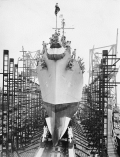
0546646 |
326k | Waller launching at Kearny, NJ, 15 August 1942. | Darryl Baker |

| 49k | Inclining test at the Bath Iron Works, 27 August 1942. | Pieter Bakels |

| 104k | On sea trials in September 1942. | Gerd Matthes |

| 104k | USS Waller (DD-466) taking on supplies from a covered barge while anchored off Fort Lafayette, New York harbor, 22 October 1942. National Archives photo 19-N-35427. | Robert Hurst |

| 78k | A view in camouflage in 1944 used in a Recognition ID packet. The ship is painted in camouflage Measure 32, Design 7d. | John Chiquoine |

| 99k | A view in camouflage in 1944 used in a Recognition ID packet. | John Chiquoine |

| 95k | Photo of the Waller by BM2c James Gilbert Dudrow, taken in Manila Bay from LCI(L)-358, circa early 1945. | Steve Dudrow |

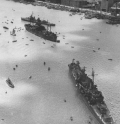
Even as the Empire surrender events were being planned and executed as August 1945 turned over in to September, US naval task groups converged on the many ports on Chinese and Korean coasts. In just days, many US surface forces were positioned as occupation forces in rivers, harbors, and bays.
These are two views of USS Waller maneuvering in the Wangpoo River to settle in to her assignment. Photos by George Lacks, Life Magazine. Blue Ridge (AGC-2) and Nashville (CL-43) are also on station. Used for educational and non-commercial purposes. | John Chiquoine |

| 142k | USS Waller as seen by Army fliers over the Whangpoo River at Shanghai, China, after the war in September 1945. NA SC221172. | John Chiquoine |

| 116k | USS Waller (DD-466) operating with the Sixth Fleet in the Mediterranean, 1950s. Courtesy of USS Waller (DD-466), 1969. Source: Naval History and Heritage Command, Photo No. NH 67924 | Mike Green |

| 78k | Admiral Arleigh A. Burke, Chief of Naval Operations, addresses the crew of USS Waller (DDE-466), in the Mediterranean Sea, 1957. Photograph received from USS Waller, 1969. Naval History & Heritage Command photo NH 67921 | Bill Gonyo/Richard Shepard |

| 130k | July 1959, Contoller awaits signal to fire weapon ALFA, NPC 1043399. | Ed Zajkowski |

| 172k | July 1959, Waller launches weapon ALFA in the Atlantic, NPC 1043097. | Ed Zajkowski |

| 164k | July 1959, spread of hedgehogs hurtle through the air after being fired from the escort destroyer Waller, NPC 1043096. | Ed Zajkowski |

| 91k | Task Group ALFA, formation portrait of the anti-submarine group's ships and aircraft, taken during 1959 exercises in the Atlantic, while Secretary of the Navy William B. Franke was embarked. Ships include the group flagship, USS Valley Forge (CVS-45) in center, two submarines, and seven destroyers. Identifiable among the latter are USS Eaton (DDE-510) at left front, USS Beale (DDE-471) following Eaton, USS Waller (DDE-466) in the center foreground, and USS Conway (DDE-507) at right front. Aircraft overhead include two formations of S2F "Trackers" from the Valley Forge air group, plus one shore-based P2V "Neptune" from Norfolk Naval Air Station, Virginia. Two HSS-1 helicopters are flying low, directly over the submarines. Official U.S. Navy Photograph. | Fred Weiss |

| 105k | As above, different view. | Fred Weiss |

| 144k | USS Valley Forge (CVS-45) Steams in formation with other units of Task Force ALFA, during anti-submarine exercises in the Atlantic, 1959. The other ships present are (from left): USS Murray (DDE-576), USS Beale (DDE-471), USS Bache (DDE-470), USS Eaton (DDE-510), USS Conway (DDE-507), USS Cony (DDE-508) and USS Waller (DDE-466). Photograph was released for publication on 3 August 1959. Official U.S. Navy Photograph, from the collections of the Naval Historical Center. | Fred Weiss |

| 206k | USS Conway (DD-507) and USS Waller (DD-466) at Fleet Week 1960 in New York City. | ETC Robert C. Wolff USN (Ret.) |

| 220k | USS Conway (DD-507), USS Waller (DD-466) and USS Cony (DD-508) at Fleet Week 1960 in New York City. | ETC Robert C. Wolff USN (Ret.) |

| 69k | In Valletta Harbor, Malta, circa 1960's. | Tommy Trampp |
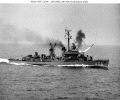
| 133k | USS Waller (DDE-466) firing Weapon Alpha during an anti-submarine warfare demonstration, 10 August 1960. Photographer: Devoe. Official U.S. Navy Photograph, from the collections of the Naval History and Heritage Command. Photo #: NH 107296. | Robert Hurst |

| 102k | Photo #: NH 67963. Destroyer Squadron Twenty-Eight Commanding officers of the squadron's ships display their Anti-Submarine Warfare "A" awards in a ceremony held on board one of the DesRon28 destroyers, circa the late 1950s or early 1960s. Flanking them are Vice Admiral Edmund B. Taylor, Commander Anti-Submarine Defense Force, Atlantic Fleet (at left) and Rear Admiral Frederick V.H. Hilles, Commander Destroyer Flotilla 4 (at right). The DesRon28 insignia is in the foreground. Those holding the "A" awards are (from left to right): Commander George R. Bryan, Commanding Officer, USS Conway (DDE-507); Commander David A. Johnson, Commanding Officer, USS Beale (DDE-471); Commander Frank C. Dunham, Commanding Officer, USS Cony (DDE-508); Commander Ralph F. Monger, Commanding Officer, USS Murray (DDE-576); Commander James L. Rothermel, Commanding Officer, USS Waller (DDE-466); and Captain Arthur G. Esch, Commanding Destroyer Division 282, who accepted the award on behalf of USS Eaton (DDE-510), three time winner of the "A" award. Photograph received from USS Waller, 1969. U.S. Naval Historical Center Photograph. | Bill Gonyo |

| 96k | Circa 1961. | Marc Piché |

| 159k | USS Randolph (CVS-15) Refueling at sea from USS Pawcatuck (AO-108), circa 1960. USS Waller (DDE-466) is refueling from the oiler's starboard side, while USS Eaton is steaming astern, waiting her turn for a "drink". Photograph received from USS Waller, 1969. | Roger Rieman |

| 84k | Pearl Harbor, October 1968 | © Richard Leonhardt |














The Waller's Decommissioning Press Package, the photos are backstamped by PH3 Meckel dated June 20 1966 at Norfolk - July 1969 | Vin Morgan |
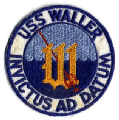
| 45k | Ship's patch | Mike Smolinski |
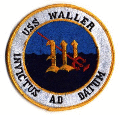
| 51k | Ship's patch | Mike Smolinski |
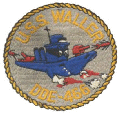
| 52k | Ship's patch | Mike Smolinski |

